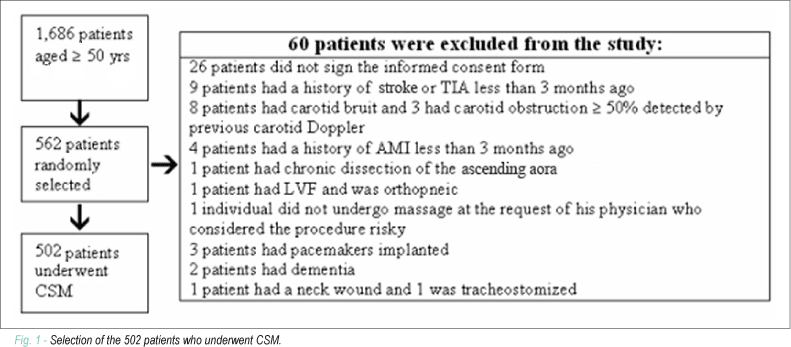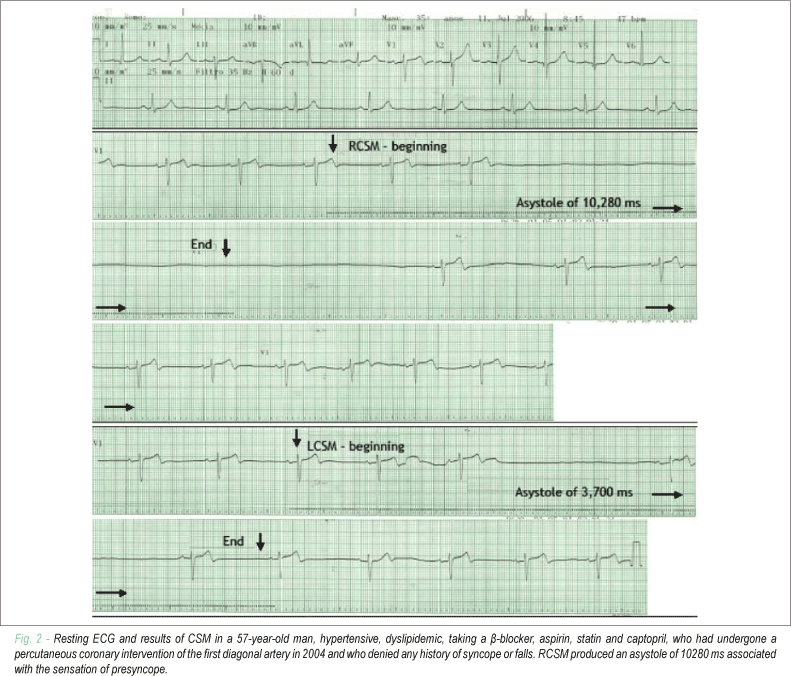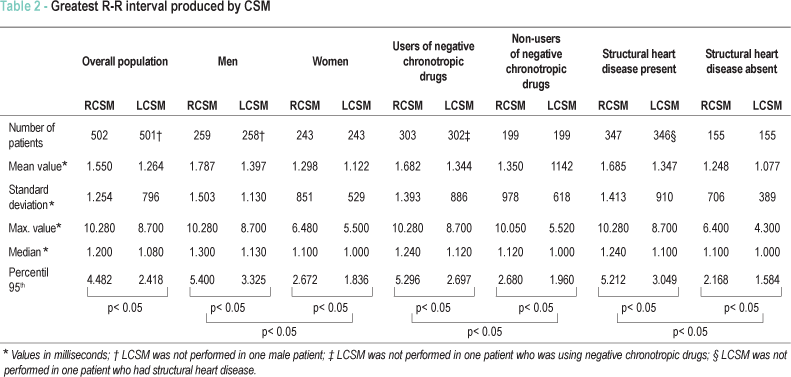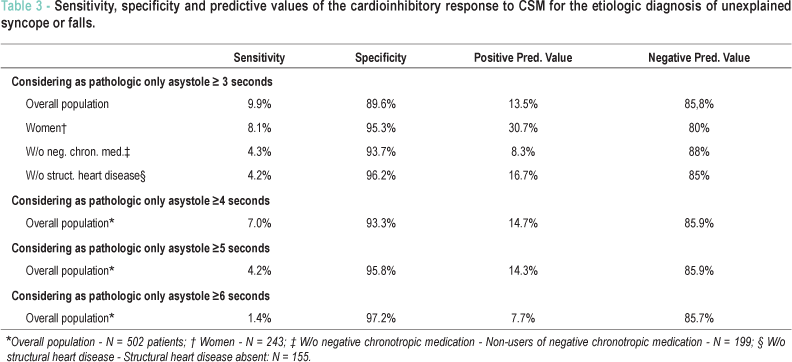Abstracts
BACKGROUND: Cardioinhibitory response (CIR) is defined as asystole >3 seconds in response to 5-10 seconds of carotid sinus massage (CSM). Pacemaker implantation is indicated for patients with unexplained syncope episodes and CIR. OBJECTIVE: To determine the prevalence and predictors of CIR in patients with a high prevalence of cardiovascular disease, and assess the clinical significance of CIR in patients with a history of unexplained syncope or falls. METHODS: Cross-section design study. Outpatients, aged >50 years, referred to the electrocardiography sector of a tertiary hospital. Those with dementia, carotid bruit, and history of myocardial infarction, stroke or transient ischemic attack in the preceding 3 months were excluded. CSM was performed by a single investigator, with the patients in the supine position. CSM was applied on the right side and then on the left side during 10 seconds each time. RESULTS: 502 patients underwent CSM. CIR was present in 52 patients (10.4%; 95% CI: 7.7%-13%). Independent predictors of CIR were male gender (OR: 2.61%; CI 95%: 1.3%-5.1%), structural heart disease (OR: 3.28%; CI 95%: 1.3%-7.9%) and baseline heart rate (P<0.05). The sensitivity of the CIR to CSM in syncope evaluation was low (9.8%). Specificity was high (89.5%), being even better in women (95.3%) and in those without structural heart disease (96.2%). CONCLUSION: CIR was detected in 10.4% of the patients aged > 50 years. In males and in patients with structural heart disease CIR was more common. In women and patients with no apparent structural heart disease, the presence of CIR was a highly specific finding in the evaluation of syncope or falls.
Carotid sinus; syncope; arrhythmia; outpatients
FUNDAMENTO: A resposta cardioinibitória (RCI) caracteriza-se por assistolia > 3 segundos em resposta a 5 a 10 segundos de massagem do seio carotídeo (MSC). O implante de marcapasso é indicado nos pacientes com síncope inexplicada e RCI. OBJETIVO: Determinar a prevalência e os preditores da RCI em pacientes com alta prevalência de doença cardiovascular. Avaliar o significado clínico da RCI em pacientes com história de síncope ou queda. MÉTODOS: Desenho transversal. Casuística: pacientes ambulatoriais, com idade > 50 anos, encaminhados ao Setor de Eletrocardiografia de um hospital terciário. Indivíduos com demência, sopro carotídeo, história de infarto agudo do miocárdio ou acidente vascular cerebral nos últimos três meses foram excluídos. Os pacientes foram submetidos a MSC direito por 10 segundos seguida de MSC esquerdo por 10 segundos. As MSCs foram realizadas na posição supina por um único investigador. RESULTADOS: No total, 502 indivíduos foram submetidos a MSC, dos quais 52 apresentaram RCI (prevalência: 10,4%; intervalo de confiança de 95% [IC95%]: 7,7%-13%). Os preditores independentes da RCI foram: sexo masculino ("odds ratio" [OR]: 2,61; IC95%: 1,3%-5,1%), cardiopatia estrutural (OR: 3,28; IC95%: 1,3%-7,9%), e freqüência cardíaca de base (p < 0,05). A sensibilidade da RCI no diagnóstico etiológico de episódios de síncope ou queda foi baixa (9,8%). Sua especificidade foi boa (89,5%), sendo melhor nas mulheres (95,3%) e nos não-cardiopatas (96,2%). CONCLUSÃO: A RCI foi encontrada em 10,4% dos pacientes com idade > 50 anos. Nos homens e nos cardiopatas, a probabilidade de a MSC provocar o aparecimento de RCI foi maior. Nas mulheres e nos pacientes sem cardiopatia estrutural aparente, a RCI mostrou ser achado altamente específico para o diagnóstico etiológico dos episódios de síncope ou queda.
Seio carotídeo; síncope; arritmia; pacientes ambulatoriais
ORIGINAL ARTICLE
Cardioinhibitory carotid sinus hypersensitivity: prevalence and predictors in 502 outpatients
Gustavo de Castro Lacerda; Roberto Coury Pedrosa; Renato Côrtes de Lacerda; Marcela Cedenilla dos Santos; Maurício de Andrade Perez; Alfredo Brasil Teixeira; Aristarco Gonçalves de Siqueira-Filho
Universidade Federal do Rio de Janeiro Hospital Geral de Bonsucesso Rio de Janeiro, RJ - Brazil
Mailing address Mailing address: Gustavo de Castro Lacerda Rua Hadock Lobo, 369/308 - Estácio 20260-131 - Rio de Janeiro, RJ - Brazil E-mail: glacerda@cardiol.br
SUMMARY
BACKGROUND: Cardioinhibitory response (CIR) is defined as asystole >3 seconds in response to 5-10 seconds of carotid sinus massage (CSM). Pacemaker implantation is indicated for patients with unexplained syncope episodes and CIR.
OBJECTIVE: To determine the prevalence and predictors of CIR in patients with a high prevalence of cardiovascular disease, and assess the clinical significance of CIR in patients with a history of unexplained syncope or falls.
METHODS: Cross-section design study. Outpatients, aged >50 years, referred to the electrocardiography sector of a tertiary hospital. Those with dementia, carotid bruit, and history of myocardial infarction, stroke or transient ischemic attack in the preceding 3 months were excluded. CSM was performed by a single investigator, with the patients in the supine position. CSM was applied on the right side and then on the left side during 10 seconds each time.
RESULTS: 502 patients underwent CSM. CIR was present in 52 patients (10.4%; 95% CI: 7.7%-13%). Independent predictors of CIR were male gender (OR: 2.61%; CI 95%: 1.3%-5.1%), structural heart disease (OR: 3.28%; CI 95%: 1.3%-7.9%) and baseline heart rate (P<0.05). The sensitivity of the CIR to CSM in syncope evaluation was low (9.8%). Specificity was high (89.5%), being even better in women (95.3%) and in those without structural heart disease (96.2%).
CONCLUSION: CIR was detected in 10.4% of the patients aged > 50 years. In males and in patients with structural heart disease CIR was more common. In women and patients with no apparent structural heart disease, the presence of CIR was a highly specific finding in the evaluation of syncope or falls. (Arq Bras Cardiol 2008; 90(3):148-155)
Key words: Carotid sinus; syncope; arrhythmia; outpatients.
Introduction
Carotid sinus hypersensitivity (CSH) is the exacerbation of a reflex present in healthy individuals. The European Society of Cardiology defined this condition as asystole lasting for at least 3 seconds, or a drop in systolic blood pressure (BP) of at least 50 mmHg, provoked by 5 to 10 seconds of carotid sinus massage (CSM).1
In most individuals, CSM causes a slight reduction in heart rate (HR), as well as in tensional levels. Two forms of response to CSM can be considered pathological: the cardioinhibitory response characterized by the presence of asystole lasting for at least 3 seconds, and the vasopressor form characterized by a reduction in systolic blood pressure (> 50 mmHg). Both may occur independently (pure cardioinhibitory or vasodepressor responses), or as a combination of the two (mixed response).1,2
Doubts still exist about the clinical meaning of the cardioinhibitory response.3,4 CSM may produce asystole lasting >3 seconds in a significant portion of the population.5,6 This behavior occurs more frequently among subjects with a history of syncope, particularly the elderly and those with structural heart disease.7,8,9
In Brazil, no studies have been published that evaluate the prevalence of cardioinhibitory response to CSM. In foreign literature, predictors of cardioinhibitory response have been described in only a few studies, most of which with a small number of patients.6,10
The aim of this study was to determine the prevalence and predictors of cardioinhibitory response to CSM in outpatients aged >50 years and with a high prevalence of cardiovascular disease. Moreover, we intended to evaluate the clinical meaning of the cardioinhibitory response to CSM among patients with a history of syncope or falls during the preceding year.
Methods
Study design - This is a cross-section design study conducted at the cardiology outpatient unit of the Hospital Geral de Bonsucesso (HGB), a public tertiary hospital. Patient recruitment was started after approval of the research protocol by the hospital's Research Ethics Committee. All patients were asked to sign the informed consent form.
Patients - Outpatients aged >50 years, who had been referred after routine cardiological examination and patients who were referred by physicians from other specialties (clinical or surgical) to undergo electrocardiogram testing (ECG), were randomly selected.
Individuals selected were interviewed by the main investigator of this study and were submitted to clinical evaluation. Patients were informed about the objectives of the study and the risks of CSM. During the interview, the primary focus was on the patient's history of unexplained syncopal episodes or falls.
Syncope was defined as a sudden and transient loss of consciousness, associated with loss of postural tone.
Unexplained falling was considered any situation in which the individual fell down without any accidental (stumbling over or being pushed) or medical (convulsion, stroke, alcohol abuse, orthostatic hypotension, and arrhythmia) reason. Patients with more than 3 falls in the preceding year were also considered as unexplained fallers, even if they reported a history of an accidental cause for these episodes.
Patients who did not sign the informed consent form and those in whom CSM was not feasible (individuals morbidly obese, with neck wounds and tracheostomy) were excluded from the study. Patients with dementia, carotid murmur or carotid Doppler exam showing >50% carotid stenosis, individuals with a history of AMI,stroke, or TIA in the preceding 3 months, those with symptomatic bradyarrhythmias, those with pacemakers and those with a history of ventricular arrhythmia were also excluded.
CSM technique employed - CSM was performed in a facility equipped with a cardiac defibrillator, transcutaneous pacemaker and all items required to perform cardiopulmonary resuscitation. The first author of this study was responsible for performing CSM in all cases.
CSM was carried out only in the supine position, initiating on the right side. Longitudinal massage was applied for 10 seconds over the point of maximal carotid pulse, just above the thyroid cartilage and below the angle of the jaw. In patients who did not present any immediate complication after one minute, the procedure was repeated on the left side. Heart rate and cardiac rhythm changes produced by CSM were recorded by the Cardiofax 9010B® electrocardiograph at a speed of 25 mm/s.
After CSM, all patients were asked about the presence of symptoms during the procedure.
The greatest R-R interval produced by CSM was measured with the help of a ruler, a magnifying glass and a compass with a precision of 20 ms.
Outcome - Cardioinhibitory response to CSM. Patients considered as having cardioinhibitory responses were those in whom CSM produced asystole >3 seconds, irrespective of the blood pressure behavior and the presence of symptoms.
Statistical analysis - In order to study the prevalence of cardioinhibitory response with 95% safety, 427 individuals would have to undergo CSM. This number was obtained based on the estimate that the prevalence of cardioinhibitory response in patients >50 years of age seen at HGB outpatient cardiology unit is equal to 12% ± 3%, and that the number of patients seen per year at this outpatient clinic is equal to 8 thousand. As our objective was also to study the predictors of cardioinhibitory response, we decided to increase the size of the sample to 500 patients.
Comparisons between the greatest R-R interval registered during CSM performed on the right side (RCSM) and on the left side (LCSM) in the overall population, male patients, female patients, users and non-users of negative chronotropic drugs, patients with and without structural heart disease, were performed using the Mann-Whitney test.
The dichotomic predictor variables of the presence of a cardioinhibitory response were determined through contingency tables and determination of the relative risk. Fisher's exact test was used to establish the value of p. Each association with p<0.05 was considered significant. The continuous variables predictors of the presence of cardioinhibitory response were compared with the use of the T test. The variables with p<0.1 in the univariate analysis were included in a binary logistic regression model (stepwise forward Wald).
Results
Description of the population:
During the recruitment period, 1,686 patients aged >50 years were seen at the HGB electrocardiography outpatient unit, and 562 patients (33.3%) were randomly selected. Sixty patients were excluded from the study (Figure 1). Table 1 exhibits a summary of the characteristics of the 502 individuals who underwent CSM.
The mean value of the greatest R-R interval produced by RCSM was greater than the mean value of the greatest R-R interval produced by LCSM. This behavior was observed in the overall population, in men, in women and in 4 groups of patients (Table 2). The mean value of the greatest R-R interval produced by CSM in men was greater than that recorded among women (p<0.05). The mean value of the greatest R-R interval produced by CSM in users of negative chronotropic drugs was greater than that in non-users of negative chronotropic drugs (p<0.05), and the mean value of the greatest R-R interval produced by CSM in patients with structural heart disease was greater than that observed among individuals who did not have structural heart disease (p<0.05) (Table 2).
Prevalence and predictors of cardioinhibitory response to CSM
CSM produced cardioinhibitory responses in 52 patients (prevalence: 10.4%; CI 95%: 7.7% to 13%). In 34 individuals, the cardioinhibitory response was detected exclusively during RCSM, and in 9, exclusively during LCSM. Nine patients presented a cardioinhibitory response during RCSM and LCSM(Figures 2 and 3).
Table 1 displays the characteristics of patients with and without cardioinhibitory response.
Patients with cardioinhibitory response had a baseline HR lower than those who did not present this response (Table 1, Figure 4).
No significant relationship was observed between the history of syncope or falls and the presence of a cardioinhibitory response to CSM. In the univariate analysis, male gender (R-R: 2.82; p<0.05), presence of known heart disease (R-R: 2.49) and structural heart disease (OR: 3.42; p<0.05) were the greatest predictors of the presence of a cardioinhibitory response to CSM (Figure 5).
Independent predictor variables of cardioinhibitory response were baseline HR (p<0.05), male gender (OR: 2.61; CI 95%: 1.3%) and the presence of structural heart disease (OR: 3.28; CI 95%: 1.3% to 7.9%).
The sensitivity of an asystole >3 seconds for the etiologic diagnosis of unexplained syncope or falls was low (9.9%), but its specificity was high (89.6%) (Table 3). This specificity was higher among women (95.3%), in those who did not use negative chronotropic agents (93.7%) and in patients with no structural heart disease (96.2%) (Table 3).
Complications from CSM:
No individual developed cardiac complications associated with CSM. Two patients had cerebrovascular complications with no sequelae. A 56-year-old man developed a visual field deficit which receded completely within 7 days, and a 71-year-old man experienced dysarthria and left-arm monoparesis, both of which receded within 30 minutes.
Discussion
Pacemaker implantation is recommended for patients with unexplained syncope in which CSM produces a pure or predominant cardioinhibitory response.1,2 The Brazilian Society of Cardiology (SBC) recommends implantation of pacemakers for individuals with recurrent episodes of syncope associated with the presence of a cardioinhibitory response to CSM.11 SBC stresses the importance of confirmation of the relationship between bradycardia and symptoms, since pauses or bradycardia with no clinical significance may easily be induced by CSM in elderly patients, especially when they are using negative chronotropic drugs.11
CSM produced cardioinhibitory responses in 52 of the 502 patients who underwent the procedure at HGB. In 86.5% of these 52 patients, the cardioinhibitory response was not associated with a past history of syncopal episodes or falls, and could be considered a false-positive response. This result raises questions about the indication of pacemaker implantation for patients who experience syncope and cardioinhibitory responses to CSM.
Recent publications have also questioned the indication of artificial cardiac stimulation.3-6 One of these publications suggests a reevaluation of the current definition of abnormal cardioinhibitory response.6
In the past, all cases in which CSM produced the appearance of a junctional or ventricular escape rhythm, atrioventricular block or pauses greater than 2 seconds were considered abnormal.12 Today, only asystole periods lasting >3 seconds are considered pathological.1,2,11 This value is based on the experience acquired with the performance of the maneuver in thousands of individuals. Approximately 50 years ago, Franke performed CSM in 3,900 patients. This author recorded pauses >3 seconds in less than 10% of the patients, and observed that such a period of asystole frequently produced some type of symptom. 13 Similar numbers were described by Sigler after the evaluation of 1,886 individuals from different age groups.14
Few trials have been conducted with the primary aim of analyzing the accuracy of the 3-second pause for the diagnosis of CSH. In one of the most cited studies in literature, McIntosh et al. performed CSM in 25 asymptomatic healthy elderly patients during 5 seconds in the supine and upright positions.15 The greatest pause observed (1,540 ms asystole) was produced by RCSM performed in the supine position.15 This result reinforced the idea that the value of 3 seconds is appropriate and capable of distinguishing individuals with normal deceleration of the heart rate from those with a pathological cardioinhibitory response.
Therefore, in asymptomatic and healthy individuals, the 3-second cutoff point seems to adequately distinguish individuals with a slight exacerbation of a reflex considered normal from those with a clearly pathological cardioinhibitory response.
However, a significant percentage of patients with syncopal episodes have some form of structural heart disease.16 It has long been known that in patients with structural heart disease the prevalence of the cardioinhibitory response is higher than that observed in healthy individuals9,17. Brignole et al. describe the presence of a cardioinhibitory response in 2% of a group of 288 healthy volunteers. This prevalence was 8.5 times lower than what they observed in 105 patients with heart diseases.9
Therefore, interpretation of the clinical meaning of a cardioinhibitory response in patients with structural heart disease is more difficult. In these individuals, the 3-second cut-off point may be inadequate.
Recently, Kerr et al. evaluated the prevalence of CSH in a population of elderly people.6 They recruited 272 volunteers with a mean age of 71 years. After clinical examination and ECG, the 272 individuals were subdivided into 2 groups. The 192 patients in the first group reported a history of syncope, falling or dizziness during the preceding year. None of the 80 patients in the second group had experienced these symptoms. All of them underwent 5 seconds of CSM in the supine and upright positions. Twenty-three percent of the 192 individuals in the symptomatic group developed cardioinhibitory responses to CSM. This prevalence was lower than that recorded for individuals with no history of syncope, falling or dizziness. Cardioinhibitory responses were observed in 25% of the 80 patients who did not have these symptoms.6 In this study, sensitivity, specificity, positive predictive value and negative predictive value of the cardioinhibitory response to CSM for the diagnosis of the causes of episodes of syncope, falling or dizziness were 23%, 75%, 69% and 29%, respectively.6
In the study by Kerr et al., 5% of the 80 patients with no history of syncope, falling or dizziness developed asystole greater than 7277 ms.6 This value is much greater than that adopted by the European Society of Cardiology for the definition of a cardioinhibitory response1, and can be attributed to the fact that 14% of the 80 patients evaluated had heart diseases, and a significant percentage of this population used some type of negative chronotropic medication.6
Five percent of the 502 patients studied at HGB presented pauses greater than 4482 ms during RCSM and greater than 2418 ms during LCSM (Table 2). When men are excluded from the analysis, the results are very close to those described by Franke and Sigler.13,14 Ninety-five percent of the 243 women presented asystole of less than 2672 ms during RCSM and less than 1836 ms during LCSM. This behavior was similar to that observed in the 155 patients with no structural heart disease and in the 199 individuals who were not taking any negative chronotropic medication (Table 2).
Thus, it seems clear that in women, in patients with no structural heart disease, and in those who were not taking negative chronotropic medication, the 3-second cut-off point is appropriate. In these individuals, the cardioinhibitory response to CSM was a specific finding for the etiologic diagnosis of syncope or falls in the preceding year (Table 3).
Nevertheless, in populations with a high prevalence of structural heart disease in which the percentage of users of negative chronotropic medication is high, caution is recommended in the interpretation of the clinical significance of CSM results. Cardioinhibitory response may be present in at least 10% of these individuals, and is more common in men, in bradycardic subjects and in those with structural heart disease.
References
Manuscript received April 22, 2007; revised manuscript received June 20, 2007; accepted August 8, 2007.
- 1. Brignole M, Albony P, Benditt DG, Bergfeldt L, Blane JJ, Bloch Thomsen PE, et al. Task Force on Syncope. European Society of Cardiology. Guidelines on Management (diagnosis and treatment of syncope update 2004. Europace. 2004; 6 (6): 467-537.
- 2. Healey J, Connolly SJ, Morillo CA. The management of patients with carotid sinus syndrome: is pacing the answer. Clin Auton Res. 2004; 14 (Suppl 1): 80-6.
- 3. Goldlist B, Naglie G. Carotid sinus syndrome in the elderly. Am J Med. 1995; 98 (1):100-1.
- 4. Coplan NL. Carotid sinus hypersensitivity and syncope cause/effect or true/true/unrelated. Arch Intern Med. 2006; 166 (5): 491-2.
- 5. Jaoude S, Salloum V. Value and limitations of carotid sinus massage in healthy elderly individuals: evaluation of diagnostic criteria for hypersensitive carotid sinus syndrome. Ann Cardiol Angeiol (Paris). 2003; 52 (6): 358-62.
- 6. Kerr SR, Pearce MS, Brayne C, Davis RJ, Kenny RA. Carotid sinus hypersensitivity in asymptomatic older persons implications for diagnosis of syncope and falls. Arch Intern Med. 2006; 166 (5): 515-20.
- 7. Freitas J, Santos R, Azevedo E, Carvalho M. Prevalência e perfil clínico da hipersensibilidade do seio carotídeo numa população com síncope inexplicada. Rev Port Cardiol. 2004; 23 (6): 835-40.
- 8. Kumar NP, Thomas A, Mudd P, Morris RO, Masud T. The usefulness of carotid sinus massage in different patient groups. Age Ageing. 2003; 32 (6): 666-9.
- 9. Brignole M, Gigli G, Altomonte F, Barra M, Sartore B, Prato R, et al. Il riflesso cardioinibitore provocato dalla stimolazione del seno carotídeo nei soggetti normali e com malattie cardiovascolari. G Ital Cardiol. 1985; 15 (5): 514-9.
- 10. Brignole M, Menozzi C, Gianfranchi L, Oddone D, Lolli G, Bertulla A. Carotid sinus massage, eyeball compression, and head-up tilt test in patients with syncope of uncertain origin and in healthy control subjects. Am Heart J. 1991; 122 (6): 1644-51.
- 11. Sociedade Brasileira de Cardiologia. Diretrizes para avaliação e tratamento de pacientes com arritmias cardíacas. Arq Bras Cardiol. 2002; 79 (supl 5): 150.
- 12. Thomas EJ. Hyperactive carotid sinus reflex and carotid sinus syncope. Mayo Clin Proc. 1969; 44(2): 127-39.
- 13. Franke J. Über das Karotissinus-Syndrome und den Sogenannten Hyperaktiven Karotissinus-Reflex. Stuttgart (Germany): Friedrich-KarlSchattauer-Verlag; 1963;149 p.
- 14. Sigler LH, The carotid sinus reflex: its importance as a vago cardiosenssitivity test. Am J Cardiol. 1963; 12: 175-83.
- 15. McIntosh SJ, Lawson J, Kenny RA. Heart rate and blood pressure responses to carotid sinus massage in healthy elderly subjects. Age Ageing. 1994; 23 (1): 57-61.
- 16. Kapoor NW. Syncope. N Engl J Med. 2000; 343 (25): 1856-62.
- 17. Lown B, Levine SA. The carotid sinus: clinical value of its stimulation. Circulation. 1961; 23: 766-89.
Publication Dates
-
Publication in this collection
04 Apr 2008 -
Date of issue
Mar 2008
History
-
Accepted
08 Aug 2007 -
Reviewed
20 June 2007 -
Received
22 Apr 2007









